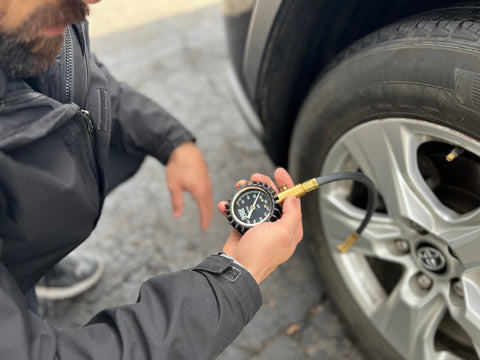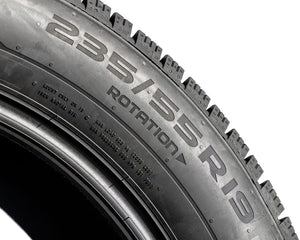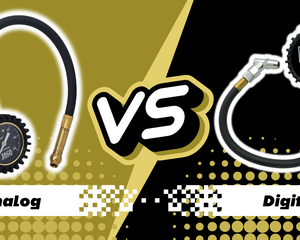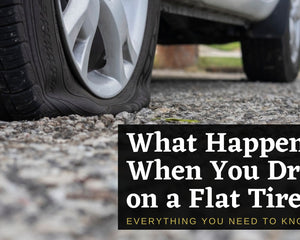
Introduction
Did you know that the correct tire pressure is crucial to your vehicle's fuel efficiency, safety, and tire lifespan? It's true, and that's where a reliable tire pressure gauge steps in. But, with a plethora of options on the market, how do you choose the right tire pressure gauge for your vehicle? Whether you're a first-time buyer or considering an upgrade, finding the perfect gauge can seem daunting. Fear not! In this comprehensive guide, we delve deep into the world of tire pressure gauges, helping you understand the importance of maintaining the right tire pressure and how to select a gauge that best suits your vehicle's needs. So, let's jump in, and take the guesswork out of choosing the right tire pressure gauge for your vehicle. Buckle up for an insightful ride on the road of tire pressure maintenance.
Why Tire Pressure Matters
Fuel Efficiency Implications
First on our list of reasons why tire pressure is paramount is its significant impact on fuel efficiency. Underinflated tires create more resistance against the road, forcing your vehicle to work harder and burn more fuel in the process. On the flip side, maintaining the right tire pressure can improve your vehicle's gas mileage by up to 3%. That might not sound like much, but over time, it adds up to substantial savings at the pump and a more eco-friendly ride.
Safety Considerations
Next, let's talk safety. Your vehicle's tire pressure directly affects its handling, traction, and braking performance, all of which are key to staying safe on the road. Underinflated tires can overheat, increasing the risk of a blowout, while overinflated tires can reduce the tire's contact with the road, leading to less grip and a bouncier ride. Correct tire pressure ensures your tires are performing optimally, providing you with a safer and smoother drive, no matter the road conditions.
Tire Longevity
Lastly, proper tire pressure is instrumental in maximizing your tire lifespan. Under or overinflated tires can lead to uneven tread wear, reducing the life of your tires and leading to more frequent and costly replacements. In contrast, maintaining the recommended tire pressure promotes even wear across the tire surface, enhancing their longevity. That means more miles before you'll need to change your tires, saving both time and money in the long run.
In a nutshell, understanding and maintaining the correct tire pressure is not just a good-to-know; it's a must-know for every driver. So, how do you keep track of your vehicle's tire pressure? The answer lies in finding the right tire pressure gauge for your needs, and that's what we'll explore in the next section.

Different Types of Tire Pressure Gauges
Navigating the myriad options of tire pressure gauges can feel a bit overwhelming, but we're here to guide you through. Let's delve into the three main types you'll likely encounter: analog, digital, and stick pressure gauges.
Analog Pressure Gauges
The first on our list, the analog pressure gauge, is the classic and perhaps the most recognized type of tire pressure gauge. Analog gauges use a Bourdon tube mechanism to measure pressure, displaying the reading on a dial face. While some might find the readings a tad harder to interpret compared to digital gauges, analog gauges are revered for their durability and ability to function without batteries. They also provide accurate readings and often come with features like a bleed valve for precise inflation control.
Digital Pressure Gauges
Next up, digital pressure gauges. As the name suggests, these gauges provide digital readings, usually on an LCD screen, making them incredibly easy to read, even in low light conditions. Digital gauges are often very accurate and might come with additional features like backlit displays, auto-shutoff to preserve battery life, and even memory functions to store readings. However, they do require batteries to operate, and they might not be as robust as their analog counterparts.
Stick Pressure Gauges
Lastly, we have stick pressure gauges. These are simple, compact, and resemble a pen in their design. Stick pressure gauges are mechanical and do not require batteries. While they are usually the least expensive option and can be convenient to carry around, they can be slightly less accurate than analog or digital gauges and may be more difficult to read.
In summary, each type of tire pressure gauge comes with its pros and cons. The choice comes down to your specific needs, preferences, and budget. Analog gauges are reliable and robust, digital gauges offer ease of reading and advanced features, while stick gauges are compact and convenient. As we move on, we'll delve into what factors you should consider to pick the best fit from these options. Keep reading to learn how to choose the right tire pressure gauge for your vehicle.

Factors to Consider When Choosing a Tire Pressure Gauge
When it comes to picking the right tire pressure gauge for your vehicle, several factors play a critical role. Let's walk through these to help you make an informed decision.
Accuracy
The first and perhaps most critical aspect to consider is accuracy. After all, the primary function of a tire pressure gauge is to provide accurate readings. Most tire pressure gauges claim to be accurate within a certain range, often +/- 1 PSI. Professional-grade gauges may offer even higher accuracy. Regardless of the type, ensure that your gauge is certified for its accuracy.
Ease of Use
Next, consider how easy the gauge is to use. Can it be used with one hand? Does it fit comfortably in your hand? Is the pressure reading easy to read? For those with vision issues, a digital gauge with a larger, illuminated display might be easier to read than an analog or stick gauge.
Size and Portability
The size and portability of the gauge also matter, especially if you intend to keep it in your vehicle. Stick pressure gauges are usually compact and easy to store, while some analog and digital gauges might be bulkier but provide more features.
Durability and Quality
Look at the durability and quality of the gauge. A good quality tire gauge should last for years. Consider the materials used (metal is generally more durable than plastic), and whether the gauge feels sturdy. Analog gauges typically win on durability as they do not have electronic parts that can fail over time.
Price
Price is another factor. While it's not necessary to buy the most expensive gauge, it's essential to find a balance between cost and quality. Usually, the price reflects the gauge's quality, accuracy, and extra features.
Extra Features
Speaking of extra features, these can include illuminated displays for reading in low-light conditions, integrated tire deflators for easy air pressure adjustments, a hose for reaching valve stems more easily, and built-in tire depth gauges. While not all drivers will need these features, they can add convenience and versatility to your tire maintenance routine.
In conclusion, choosing the right tire pressure gauge involves a careful consideration of accuracy, ease of use, size, durability, price, and any extra features you may find valuable. By taking these factors into account, you can ensure that you select a gauge that is both functional and suited to your particular needs, helping to keep your tires in optimal condition for the road ahead.

Understanding Your Vehicle's PSI Requirements
Knowing your vehicle's PSI (Pounds per Square Inch) requirements is crucial to maintaining proper tire pressure. A tire pressure gauge is a handy tool, but it's even more beneficial when you know what tire pressure is recommended for your vehicle.
Finding your vehicle’s recommended tire pressure
So, where can you find your vehicle’s recommended tire pressure? Most often, this information is readily available in your vehicle’s owner's manual. If not, it's usually printed on a placard attached to the vehicle's door edge, doorpost, glove box door, or fuel door. Remember that the recommended tire pressure may vary depending on the load of the vehicle and the tire's size, so be sure to refer to your specific vehicle’s documentation. The recommended PSI typically ranges between 30 and 35 PSI for most passenger vehicles.
Dangers of over-inflation and under-inflation
Understanding the dangers of over-inflation and under-inflation can help emphasize the importance of proper tire pressure. Over-inflated tires are more susceptible to damage when hitting a pothole or debris on the road. They may also result in a less comfortable ride as they may create an unnaturally hard ride quality.
Under-inflation, on the other hand, can cause tires to wear prematurely and unevenly due to increased friction. This can potentially lead to tire failure, affecting your vehicle's handling and safety. Furthermore, under-inflated tires have a higher rolling resistance, which means your vehicle uses more fuel to move forward.
Knowing your vehicle's PSI requirements and maintaining the recommended tire pressure is key to maximizing your tires' lifespan, optimizing fuel efficiency, and ensuring your vehicle's overall performance and safety. Whether your tires are over-inflated or under-inflated, the risks are significant, highlighting the importance of regular tire pressure checks with a reliable tire pressure gauge.
How to Use a Tire Pressure Gauge
Having a tire pressure gauge at your disposal is excellent, but understanding how to use it properly is equally important. Regularly checking your tire pressure can help you maintain optimal tire performance and vehicle safety. Here's a step-by-step guide on checking tire pressure and maintaining accurate tire pressure, along with some top tire pressure gauge recommendations to keep your tires in perfect condition.
Step-by-step guide on checking tire pressure
1. Ensure Tires are Cold
For the most accurate reading, check your tire pressure when the tires are cold. This is usually after the car has been stationary for a few hours or hasn't been driven more than a mile or two.
2. Find the Valve Stem
This is typically a small protruding rubber cylinder on your tire. Remove the valve cap and keep it in a safe place.
3. Attach Your Gauge
Place the tire pressure gauge onto the valve stem. If using a digital gauge, the tire pressure will appear on the display. If using an analog or stick gauge, the meter or rod will pop out to show the pressure.
4. Read the Pressure
Record the tire pressure reading. Compare it with the recommended tire pressure for your vehicle.
5. Adjust Tire Pressure if Necessary
If your tire pressure is not within the recommended range, adjust accordingly. If under-inflated, fill with air until it reaches the correct pressure. If over-inflated, release some air and check the pressure again.
6. Replace Valve Cap
Once you have achieved the correct tire pressure, ensure to replace the valve cap. This helps protect the valve from dust and debris.
Best practices for maintaining accurate tire pressure
To maintain accurate tire pressure, it's recommended to check your tire pressure at least once a month and before long trips. Seasonal changes can significantly affect tire pressure, so consider checking more often in winter and summer. Remember, proper inflation is key to fuel efficiency, tire longevity, and overall vehicle safety.
Reviewing the Top Tire Pressure Gauges
Now, let's talk about some of the top tire pressure gauges you might consider for your vehicle. Among these, we proudly recommend our own range of tire pressure gauges:
Best Analogue Tire Pressure Gauges
1. JACO ElitePro Tire Pressure Gauge - 100 PSI

The JACO ElitePro Tire Pressure Gauge is a professional-grade gauge that offers accurate readings up to 100 PSI. Featuring a solid steel construction, an easy-to-read glow-in-the-dark dial face, and an extended 360-degree swivel chuck, it provides exceptional durability and usability. With an integrated air bleeder valve, it allows for precise tire pressure adjustments with ease.
2. JACO FlowPro Digital Tire Inflator Gauge - 100 PSI

The JACO FlowPro Tire Inflator Gauge combines the convenience of an inflator and gauge in one. With a maximum reading of 100 PSI, this gauge features an ergonomic pistol grip design and a heavy-duty air hose for effortless tire inflation. It also includes an easy-to-read dial, an integrated air bleeder valve, and a lock-on chuck for hands-free operation, making it a versatile tool for quick and accurate pressure adjustments.
3. JACO Elite Tire Pressure Gauge - 60 PSI

The JACO Elite Tire Pressure Gauge is a reliable and accurate gauge with a maximum reading of 60 PSI. Designed for precision, this analog gauge features a robust construction, an extended swivel chuck for easy access to valve stems, and a built-in air bleeder valve for precise pressure adjustments. It's a durable and essential tool for maintaining optimal tire pressure.
Best Digital Tire Pressure Gauges
1. JACO ElitePro Digital Tire Pressure Gauge - 200 PSI

The JACO ElitePro Digital Tire Pressure Gauge is a high-performance gauge that offers digital accuracy up to 200 PSI. Designed for professional use, it features a rugged and impact-resistant construction, an extra-large backlit display for easy reading, and a 360-degree swivel chuck for effortless access to valve stems. With an air bleeder valve and multiple pressure units, it provides precise readings and versatility for various applications.
2. JACO FlowPro Digital Tire Inflator Gauge - 200 PSI

The JACO FlowPro Digital Tire Inflator Gauge is a versatile tool that combines the functionality of an inflator and gauge. With a maximum reading of 200 PSI, it offers precise digital measurements and effortless tire inflation. Featuring a heavy-duty 18-inch air hose, an ergonomic grip, and an illuminated display, it allows for convenient operation and accurate pressure adjustments. This inflator gauge is a reliable choice for professionals and enthusiasts alike.
3. JACO Elite Digital Tire Pressure Gauge - 100 PSI

The JACO Elite Digital Tire Pressure Gauge provides precise and instant digital readings up to 100 PSI. Its compact design, backlit LCD display, and ergonomic grip make it easy to use in any lighting condition. With a durable construction and a built-in air bleeder valve, this gauge offers both accuracy and convenience for maintaining proper tire pressure.
Choose the JACO tire pressure gauge that suits your specific needs and experience the quality, accuracy, and durability that come with the trusted JACO brand.
Final Thoughts
There's never been a better time to prioritize your vehicle's tire health and overall performance. We invite you to browse through our extensive range of JACO tire pressure gauges. Our products are designed with utmost precision, ensuring reliable and accurate readings every time. And with options catering to different budgets, there's sure to be a JACO gauge that fits your needs.
Check out JACO's tire pressure gauges today and empower yourself with a tool that offers peace of mind and helps keep your vehicle in optimal running condition. After all, maintaining the right tire pressure is not just a matter of performance and efficiency, but also of safety.
And remember, it's not just about choosing a tire pressure gauge—it's about choosing the right one. Trust JACO to be your partner in maintaining your vehicle's tire health. Start your journey with us today. Thank you for reading, and safe driving!




